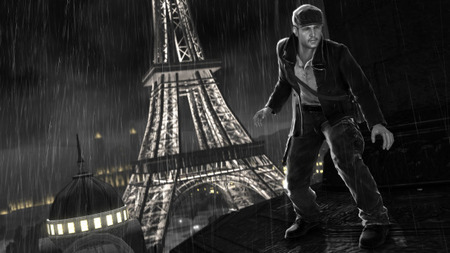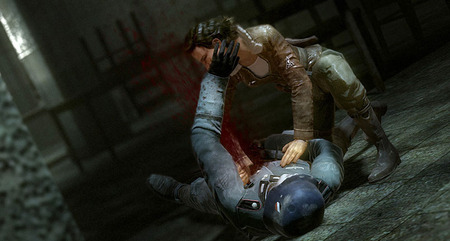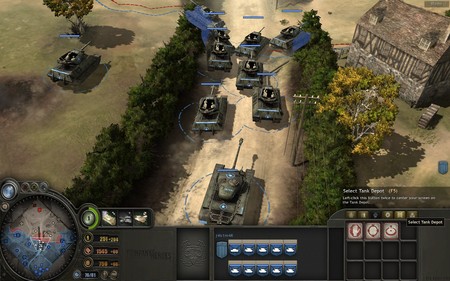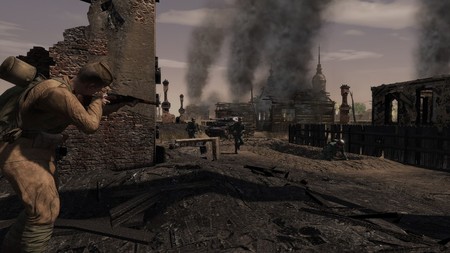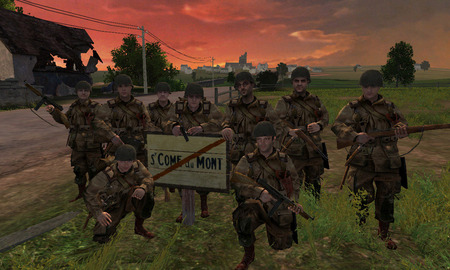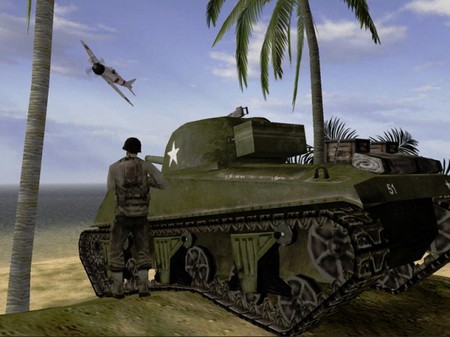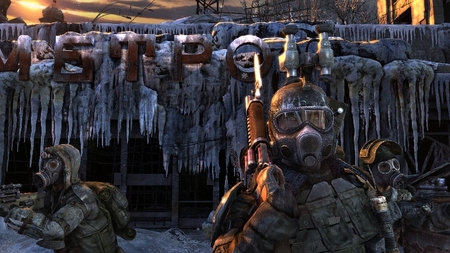From massive, free-to-play vehicular battlefields to complex wargames, you’re bound to find something below to keep you duking it out for countless hours in our round-up of WW2 games. Starting with…
10. The Saboteur
Pandemic Studios, 2009
The Saboteur’s unlikely hero—Irish racecar driver Sean Devlin—is a welcome change of pace from the hyper patriotic grunts found in most WWII games. Loosely based on the story of racer/spy William Grover-Williams, Sean aids the French Resistance in undermining the Vichy regime mostly because he’s out for a spot of apolitical revenge against a local Nazi. As players liberate Paris and the French countryside from occupation, the grayscale filter that normally overlays the game’s environments is lifted and color restored. The Saboteur is not only a lot of fun, it also shows that the Allied victory sometimes owed as much to partisan resistance as it did to traditional military campaigning.
9. Velvet Assassin
Replay Studios, 2009
Velvet Assassin is clunky and weird but ultimately pretty great. Its main character is an opium-addicted secret agent (based on real-life spy Violette Szabo) and its missions are concerned more with quiet sneaking than frantic gunplay. Yeah, the stealth can be a bit more frustrating than fun and Violette’s special power—shooting morphine so she can slow down time and execute enemies in a blood-stained nightie—makes it hard to take the grim storyline too seriously, but Velvet Assassin is memorable because it’s unique. Just as The Saboteur portrays another side of WWII through its look at citizen uprising, Velvet Assassin offers a good reminder that the war was fought by more than just stoic, uniformed men.
8. Company of Heroes
Relic Entertainment, 2006
Less concerned with marksmanship than tactical smarts, Company of Heroes is a game about controlling battle on a large scale. Successfully pulling off a carefully formulated plan makes the player feel like a master general—even if that player is as chronically inept at real-time strategy games as I am. Assuming the perspective of an invisible, god-like troop commander also makes Company of Heroes an inherently dispassionate look at each bloody fight’s human cost, allowing the audience to experience the weirdly statistical calculations that must have run through the minds of Generals Patton or MacArthur.
7. Red Orchestra 2: Heroes of Stalingrad
Tripwire Interactive, 2011
Everyone loves to imagine that they’d be a hero if thrust into a war. Red Orchestra 2 deserves credit for swiftly disabusing players of that notion. Soldiers go down with a single well-placed shot, gun sights must be dialed in by hand according to target range and actual, honest-to-god ballistics are used to determine bullet drop over long distances. The end result of this dedication to realism is a game where death is swift and constant. And it turns out that WWII without recharging health and arcade-style shooting is a grim affair.
6. Brothers in Arms: Road to Hill 30
Gearbox Software, 2005
The Brothers in Arms series isn’t much for narrative originality, but it compensates for its straight-up Band of Brothers rip-off story with light tactical systems that make players feel like an actual squad leader. Commanding the same soldiers throughout an entire campaign makes it an appropriately heavy bummer to lose a fellow trooper during a hectic firefight, too.
5. Battlefield 1942
EA Digital Illusions CE, 2002
Listen, if you’re going to turn a historical event as profoundly awful as World War II into a fun game, you might as well dispense with any pretense of story. Battlefield 1942 is a nightmare—a never-ending war, interminably fought on hundreds of servers—made into time-wasting joy. People have been playing this game for longer than the actual Second World War lasted. That probably means something.
4. Medal of Honor: Frontline
EA LA, 2002
Medal of Honor was, at one point in time, Steven Spielberg’s baby. Nowhere is the homage to Saving Private Ryan clearer than in Frontline, a game that mixes black-and-white archival footage (overlaid, of course, with melodramatic bugling) and arcade-style Nazi shooting. Its American soldiers are square-jawed, everyday heroes, dismantling the German war machine one “cinematic” level at a time. This may just be the archetypal example of the World War II videogame. And it’s good fun as long as you don’t think too hard about it.
3. Metro 2033
4A Games, 2010
Pandemic Studios, 2009
Replay Studios, 2009
Relic Entertainment, 2006
Tripwire Interactive, 2011
Gearbox Software, 2005
EA Digital Illusions CE, 2002
EA LA, 2002
4A Games, 2010
Neither of the Metro games are set in World War II proper, but in spirit they belong indelibly to that time. Ukrainian developer 4A Games set forward a chilling vision of a post-apocalyptic future where nuclear annihilation reduces Moscow’s population to warring tribes, living in the city’s subway tunnels. What’s notable is how stuck the game is in a WWII mentality. The war between fascists and communists rages on even after the bomb has destroyed the known world. Developed by Ukrainians and set in Russia, Metro puts forth the dark suggestion that the political struggles at the heart of the Second World War—as well as the fallout of its conclusion—will continue unabated, long into the future. Lately, that seems like a point worth remembering
2. Day of Defeat: Source
valve,2005
A multiplayer only, team based first person shooter, Day of Defeat: Source allows players to join either the United States Army or the German Wehrmacht forces and compete against each other in a variety of different game modes. The game featured incredible graphics for its time and had realtime achievement tracking.
1. Call of Duty: World at War
Activision,2008
